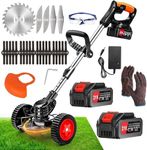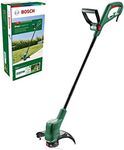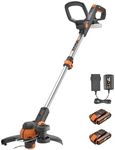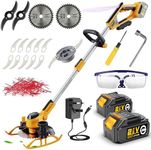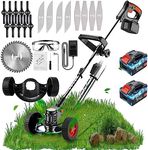Buying Guide for the Best Weed Trimmers
Choosing the right weed trimmer can make your yard maintenance tasks much easier and more efficient. The key is to understand the different features and specifications that can affect performance, ease of use, and suitability for your specific needs. By focusing on these aspects, you can find a weed trimmer that fits your yard size, type of vegetation, and personal preferences.Power SourceWeed trimmers can be powered by gas, electricity, or batteries. The power source affects the trimmer's performance, weight, and convenience. Gas-powered trimmers are typically more powerful and suitable for large areas with thick vegetation, but they are heavier and require more maintenance. Electric trimmers are lighter and quieter, ideal for small to medium yards, but they need a power outlet and may have limited range due to the cord. Battery-powered trimmers offer mobility and are easy to start, making them great for small to medium yards, but they may have limited run time depending on the battery capacity. Consider the size of your yard and the type of vegetation you need to trim when choosing the power source.
Cutting WidthThe cutting width of a weed trimmer determines how much area it can cover in a single pass. A larger cutting width means you can trim more grass or weeds at once, which is useful for larger areas. Cutting widths typically range from about 10 to 18 inches. For small yards or precision work, a smaller cutting width may be more manageable. For larger areas, a wider cutting width can save time and effort. Consider the size of your yard and how much precision you need when selecting the cutting width.
WeightThe weight of a weed trimmer affects how easy it is to handle and maneuver. Lighter trimmers are easier to carry and use for extended periods, making them suitable for smaller yards or users who may not have a lot of strength. Heavier trimmers, often gas-powered, may offer more power but can be tiring to use for long periods. Consider your physical strength and the duration of your trimming tasks when choosing the weight of the trimmer.
Shaft TypeWeed trimmers come with either a straight or curved shaft. A straight shaft is generally longer and provides better reach, making it suitable for trimming under bushes and in hard-to-reach areas. A curved shaft is shorter and can be easier to handle, offering better balance and control for trimming around flower beds and fences. Your choice should depend on the type of trimming you need to do and your comfort with handling the trimmer.
Line Feed SystemThe line feed system determines how the trimmer line is advanced during use. There are three main types: bump feed, automatic feed, and fixed line. Bump feed systems require you to tap the trimmer head on the ground to release more line, offering control over line usage. Automatic feed systems release line as needed without user intervention, which can be convenient but may use more line. Fixed line systems use pre-cut lengths of line, which can be easy to replace but may require more frequent stops. Consider how much control you want over line usage and how often you want to stop to adjust the line.
